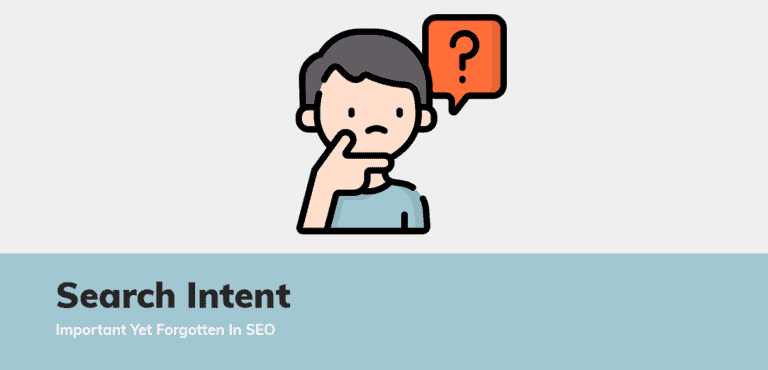What is search intent?
Search intent, also known as user intent or keyword intent, is the main goal of a user when searching for a query on search engines. In simpler terms, it’s what the user is looking for.
Why does search intent matters?
Search intent matters because Google is looking to provide the best results for their users. By providing search results that you are looking for, you’re most likely to use Google again, right?
Now imagine if Google didn’t display the results that you’re looking for. You would use other search engines like Yahoo, Bing, or even DuckDuckGo.
What happens if you and other users stop using Google?
There will be lesser people clicking on ads, and they will earn lesser ad revenue. And we all know that’s not what Google wants.
Despite what you may know about keyword research, doing keyword research itself isn’t sufficient to rank. It is always important to determine the search intent after.
This helps you determine what users are looking for and increases your chances of getting on the first page of Google.
What are the types of search intent?
The different types of search intent keywords in SEO are
- Informational intent keywords,
- Navigational intent keywords,
- Commercial intent keywords, and
- Transactional intent keywords
Informational keywords
Informational keywords are keywords that users search for when they are looking purely for information. These keywords generally have the highest levels of search volume due to their informative nature.
Despite the high search volumes, informational keywords usually contain the least intention of purchasing something. This is because users are only trying to find out more about a topic and have no interest in buying yet.
Below are examples of informational keywords:
“What is SEO?”
“Who is Johnny Bravo?”
“HDB price”
Navigational Keywords
Navigational keywords are keywords that users search for when they are looking for a specific product, service, or brand. These types of keywords generally have lower search volumes than informational keywords.
An example of a navigational keyword is “Facebook”. As you can tell, the user is probably looking for Facebook’s website and felt that it was easier to Google it instead of typing in the URL.
Here are more examples of navigational keywords:
“Moz website”
“Paypal login”
“Dollar Bureau“
In my opinion, navigational keywords usually involve current customers looking for your website. However, it is possible that the user has completed their research and are looking for your website to make a purchase.
Commercial Keywords
Commercial keywords are keywords that users search for just before they’re about to buy something. This means that they are in their final stages of research and are looking for the best product or service for themselves.
These keywords generally have lower search volumes than navigational and informational keywords. Despite lower search volumes, commercial intent keywords possess a higher intention of buying.
Examples of commercial intent keywords are:
“Ahrefs vs SEMrush”.
“MacBook Air review”
“Best SEO freelancer in Singapore“
From the above query, it can be seen that users are at their final stages of the sales funnel and are ready to buy from you.
Transactional keywords
Transactional keywords are keywords that users search for when they are ready to make a purchase. These types of keywords generally have the least amount of search volume but have the highest commercial value.
Here are some examples of transactional intent keywords:
“Buy iPhone X”
“Zalora coupon”
“hire Firdaus Syazwani”
From the above keywords, you can tell that they are READY to buy, making transactional keywords one of the best keywords to go after.
Many sources exclude commercial intent keywords as a type of search intent due to the overlapping similarities between commercial and transactional searches.
However, I prefer to separate them due to the slight difference in the buyer’s mentality. This is so that I can write relevant content to tailor towards each audience in the different stages of the sales journey.
How can you determine the search intent?
There are 2 ways that I use to identify the users’ intent. Either I make an inference based on the search query itself, or I just check the search engine results page (SERPs).
Inferring the keyword intent
This is the fastest method to determine the searcher’s intent. However, it’s not entirely foolproof.
Based on my above examples of each type of keyword, you’ll notice that they have their own sets of unique modifiers that make it pretty easy to distinguish them apart.
Inferring informational keywords
As mentioned, informational intent keywords are keywords that searchers use to find information. This can easily be inferred through the use of its own set of modifiers.
Generally, questions are regarded as informational. Other types of modifiers in this category would be “guide”, “tutorial”, “tips”, “ideas”, “how to” .. you get the point.
Inferring navigational keywords
I don’t think I have to explain much here do I? As long as the keyword includes
- A brand name
- A product name
- service name
It’s a navigational keyword.
Inferring commercial keywords
Generally, the way to infer commercial intent is through the use of modifiers that implies comparison, a review, or a list of items.
Some modifiers I use to identify these keywords are:
- Best
- Top
- Vs
- Review
- List
Inferring transactional keywords
Modifiers for transactional intent keywords can be identified relatively easily. They usually imply purchase intent. (No shit, Sherlock)
Examples of modifiers for transactional keywords are:
- Buy
- Coupon
- Hire
- Order
- Price
- Cheap
As you can see from the above examples, inferring keyword intent is pretty simple just by the use of their respective modifiers. However, as I said, it’s not foolproof.
Some keywords have ambiguous intentions to it. Let me illustrate. Without Googling for the below keyword, try to identify the intent
“SEO agencies in Singapore”
Are users searching for a list of SEO agencies available in Singapore? (Commercial keyword)
Could they be looking to hire an SEO agency? (Transactional keyword)
Or could they just be looking for information regarding SEO agencies in Singapore? (Informational keyword)
If you can’t seem to figure it out, that’s where you have to look at the search results.
Identifying search intent through the search results
The most accurate (and time-consuming) way of identifying search intent is by doing a Google search for that search query. After many searches done by billions of users over the years, Google’s algorithm is smart enough to know what searchers are actually looking for.
That’s why it’s the safest bet to determine search intent.
Do a Google search for the search term “SEO agencies in Singapore” now, you’ll actually see a mixed intent in the search result.
- You’ll see a blog post with a list of SEO agencies in Singapore and how to choose the best one for yourself. (Informational query)
- You’ll also see a landing page from Clutch.co showing you a list of the top SEO agencies in Singapore. (Transactional query)
- The bottom 8 of the SERPs are just different SEO agencies’ landing pages. (Commercial query)
From here, you can tell that the user intent is mostly catered towards a commercial intent, and that users are primarily looking to hire an SEO agency.
However, there will be instances where you’ll find an equal mix of search intent. That’s where things get confusing.
What happens if it’s a mixed search intent?
If it’s a mixed search intent, chances are you can choose either type of intent to write about.
Informational pieces, list type posts, product pages, or even a video can be used to rank for that target keyword!
But it’ll definitely be a challenge to get on the first page.
My favourite is writing a skyscraper article and creating a video to supplement the post. This article then covers all 4 aspects of intent, increasing my chances of getting on the first page.
The only trade-off? My time.
But hey, if it works, it works.
So should I target only transactional and commercial keywords?
No. Even though it might seem tempting to target purely transactional and commercial keywords, it might not be the best strategy you should take.
Firstly, some prospects are at different stages of the sales funnel. A typical prospect goes from looking for a solution to their problems, comparing their options, before deciding to purchase your products/services.
Naturally, you might not be able to attract the majority. But there are also a lot more people who haven’t even heard about you. How can a customer buy from you if they don’t know you?
And part of your marketing strategy is to get yourself known out there.
Therefore, a balance must be struck to educate, attract, and funnel these prospects to purchase from you.
Conclusion
Despite what you may know about keywords in SEO, you must never forget to identify the search intent. User intent gets you on the first page and keeps you there.
Proper identification of the intent also allows you to write copy based on what the searcher is looking for. This way, you not only reduce your bounce rate, but also increase your chances of converting visitors into leads, and leads into customers.
Also, always remember to always double-check the search intent even after inferring. You won’t get it wrong this way!
If this post was helpful, you’d benefit from joining my Telegram Channel where I share exclusive knowledge on how I do SEO.




